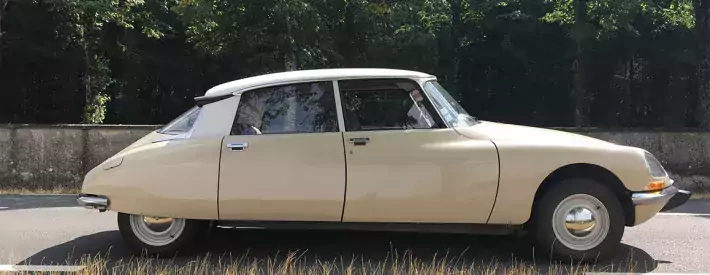The day I met my hero… the Citroën DS

In this article: Motoring writer and UK Car of the Year judge Alex Robbins the day he got to drive the car of his childhood dreams in the French countryside
How would you like to head over to France next week and have a go in a Citroën DS?” asked the editor of the newspaper I was working for. This would have been a plum gig in anyone’s book, but for me, it was the opportunity of a lifetime.
Suffice to say, growing up, I was not your average car nut. Where my peers had posters of Ferraris and Lamborghinis on their walls, for me, the DS was the height of glamour.
This was a deeply unfashionable point of view back then, but I’m glad to say that the rest of the world has since caught up. I’m no longer the odd one out for liking weird old Citroëns. Sadly, that also means prices have shot up, so owning one remains a distant dream. But a chance to drive one was the next best thing. It was all I could do to stop myself yelping down the phone.
1973 D Special
So that was how I found myself in the village of La Ferté-Vidame in northern France on a blazing hot summer’s day, gazing lasciviously at the “beige vanneau” flanks of a 1973 D Special. That badge marked it out as a lower-spec member of the DS range, with a slightly asthmatic 2.0-litre engine and a four-speed manual gearbox, instead of the clever clutchless semi-automatic fitted to some of the more palatial models.
Having said that, this particular example was rather special: it was part of Citroën’s Conservatoire, a collection of more than 400 classic Citroëns owned by the company and stored just north of Paris. Better not break it, then. And as if that wasn’t pressure enough, the Conservatoire’s curator, Denis Huille, would be sitting in the passenger seat for the whole of my drive.
Things didn’t start well. Before setting off, Denis warned me to be careful of the brakes. In older Citroëns with oleopneumatic suspensions, they’re famously fierce. “I think they take maybe 500 miles to get used to,” he said, and he wasn’t wrong.
Just when I thought I was getting the hang of them, Denis, who was directing me, called a left turn at the last minute, and I jammed on the button-like pedal without thinking. Denis’s seat unlatched and clattered forward, sending him sprawling over the black plastic dashboard. Ah.
I offered profuse apologies, but happily it turned out that there was no lasting damage – either to Denis or the car. We soon slipped out of the village’s tight streets and were bounding through those gloriously wide tracts of French countryside that seem to go on forever. The flat fields and vineyards were punctuated by sleepy villages and hemmed in by lush green forests, gently undulating hills and a deep blue sky.
Bumbling along, the DS felt unctuously, lavishly Gallic, as though someone had distilled the concept of Frenchness into a single moment. All we needed was some Edith Piaf to complete the scene. I did ask, but sadly the stereo was defunct. I didn’t even mind that the engine was a bit rubbish. With just 98bhp, it’d be an understatement to say that the D Special was somewhat lacking. Mind you, what power it did have was served up at the lower end of the rev range, so while progress was leisurely, it never felt strained.
Changing gear was a challenge at first. The column shift took a bit of getting used to for someone accustomed to floor mounted shifters. But I got the hang of it eventually. And when not pressed into service negotiating the gearbox, my palm rested in the nook between the rim of the steering wheel and the single spoke, my other arm dropped lazily on the ledge of the open window as the warm breeze streamed in. I couldn’t have been happier.
Of course, it’s the oleopneumatic suspension that the DS is famous for, and I’d waited 30 years to find out what it felt like. I wasn’t disappointed.
Cruising along these glossy, smooth roads, the impression of gliding a couple of inches above the road surface was uncanny. Motoring journalists have long pulled out the old “magic carpet” cliché to describe riding along in Citroëns that use the air and oil suspension system, but that’s because it really does feel as though you’re riding on a cushion. The lumps and bumps of the road beneath you are barely detectable.
Along rutted lanes and over speed bumps in town, the suspension couldn’t keep up with the smaller vibrations, but even these were absorbed by the pillowy seats, with the result that you didn’t feel them so much as hear them.
What I wasn’t prepared for was the DS’s composure in bends. With suspension this soft, I was expecting it to feel wallowy. But while there was some body roll, it was much more controlled than the sort of lurchy feeling you get in many cars of this era. Plenty of grip and light, direct steering meant I was soon confident enough to hustle the DS along.
I could have driven the DS all day long and carried on into the sunset. But sadly, my time with this wonderful old car had to come to an end. I pulled up and pressed the lovely Art Deco door handle, climbed out and returned to reality from my blissful Francophile reverie. I’ve been so lucky to experience some truly incredible drives in my time – but that half an hour with Citroën’s goddess is the one I’ll treasure most of all.




